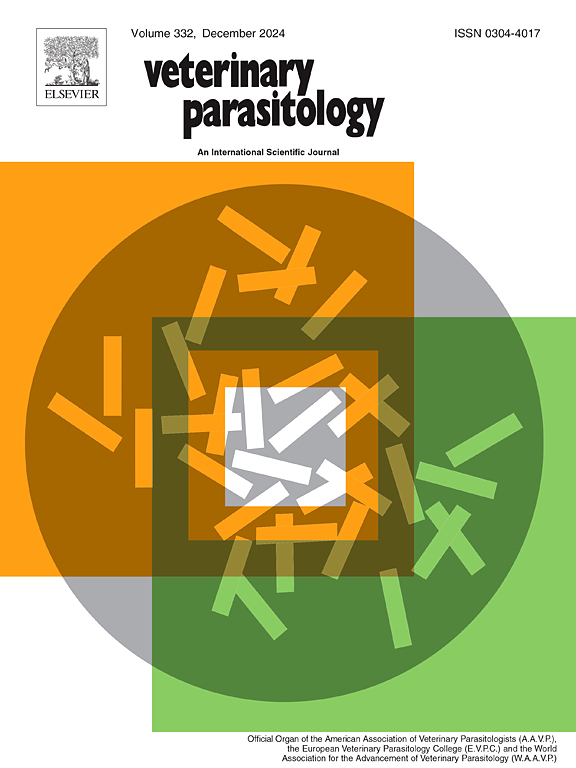In vitro, field, and in vivo trials of Metarhizium anisopliae isolate IBCB425 against Haemonchus contortus
IF 2
2区 农林科学
Q2 PARASITOLOGY
引用次数: 0
Abstract
The fungus Metarhizium anisopliae IBCB425 was tested against Haemonchus contortus in several trials. Coprocultures containing approximately 10,000 H. contortus eggs were inoculated with 105, 106, 107, 108, and 109 conidia and a control. After ten days at room temperature, larvae were recovered, counted, and checked for motility. Treatment with 108 and 109 conidia reduced larval recovery, and all concentrations diminished motility compared with the control (p < 0.05). Subsequently, parcels demarcated on an animal-free paddock were artificially contaminated with 80,000 H. contortus eggs and were sprayed twenty days later with 109, 1010, and 1011 conidia/m2 and a control. After thirty days, grass samples were collected to recover larvae and analyze dry matter (DM). Spraying with 1011 conidia/m2 reduced motility compared with the control (p < 0.05). Later, two parcels were demarcated on a naturally infected paddock grazed by mixed-breed sheep. One parcel was sprayed with 2 × 1013 conidia/ha, and the other served as control. Treatment was applied five times at 30 – 45 days intervals, from May to October. Before spraying, grass samples were collected to recover nematodes and calculate DM. No treatment-related effects were observed. Then, these parcels were fenced, and tracer groups, blocked according to age, sex, and fecal egg count (FEC), were allocated to each parcel and grazed for 35 days when males were slaughtered. No effects were detected on FECs and abomasal worm burdens. Coprocultures from both groups yielded moldy larvae, which might indicate gut survival.
金龟子绿僵菌分离株IBCB425对弯曲血蜱的体外、田间和体内试验
对金龟子绿僵菌IBCB425进行了抑菌试验。分别接种105、106、107、108和109个分生孢子和一个对照,共培养约10000个弯纹圆蝽卵。在室温下放置10天后,回收幼虫,计数并检查运动情况。108和109分生孢子处理降低了幼虫的恢复,与对照组相比,所有浓度都降低了幼虫的活动力(p <; 0.05)。随后,在一个无动物围场上圈定的地块上人工污染8万个柔纹夜蛾卵,20天后分别喷洒109、1010、1011个分生孢子/m2和对照。30 d后采集草样,回收幼虫,分析干物质(DM)。喷施1011个分生孢子/m2时,活动力较对照降低(p <; 0.05)。后来,在一个由杂交绵羊放牧的自然感染的围场上划分了两个地块。喷施2 × 1013个分生孢子/ha,另作对照。从5月至10月,每隔30 - 45天进行5次治疗。喷洒前采集草样恢复线虫并计算DM。未观察到与处理相关的效应。然后将这些地块围起来,根据年龄、性别和粪蛋数(FEC)分组,在每个地块上分配示踪剂组,在公羊屠宰时放牧35 d。对FECs和皱胃蠕虫负荷没有影响。两组的共培养都产生了发霉的幼虫,这可能表明肠道存活。
本文章由计算机程序翻译,如有差异,请以英文原文为准。
求助全文
约1分钟内获得全文
求助全文
来源期刊

Veterinary parasitology
农林科学-寄生虫学
CiteScore
5.30
自引率
7.70%
发文量
126
审稿时长
36 days
期刊介绍:
The journal Veterinary Parasitology has an open access mirror journal,Veterinary Parasitology: X, sharing the same aims and scope, editorial team, submission system and rigorous peer review.
This journal is concerned with those aspects of helminthology, protozoology and entomology which are of interest to animal health investigators, veterinary practitioners and others with a special interest in parasitology. Papers of the highest quality dealing with all aspects of disease prevention, pathology, treatment, epidemiology, and control of parasites in all domesticated animals, fall within the scope of the journal. Papers of geographically limited (local) interest which are not of interest to an international audience will not be accepted. Authors who submit papers based on local data will need to indicate why their paper is relevant to a broader readership.
Parasitological studies on laboratory animals fall within the scope of the journal only if they provide a reasonably close model of a disease of domestic animals. Additionally the journal will consider papers relating to wildlife species where they may act as disease reservoirs to domestic animals, or as a zoonotic reservoir. Case studies considered to be unique or of specific interest to the journal, will also be considered on occasions at the Editors'' discretion. Papers dealing exclusively with the taxonomy of parasites do not fall within the scope of the journal.
 求助内容:
求助内容: 应助结果提醒方式:
应助结果提醒方式:


